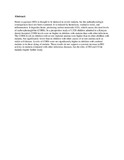Carboxyhemoglobin levels in Kenyan children with Plasmodium falciparum malaria

View/
Date
2004Author
Cunnington, AJ
Kendrick, SFW
Wamola, B
Type
ArticleLanguage
enMetadata
Show full item recordAbstract
Heme oxygenase (HO) is thought to be induced in severe malaria, but the pathophysiologic consequences have not been examined. It is induced by hemolysis, oxidative stress, and inflammation. It degrades heme, producing carbon monoxide (CO), which causes elevated levels of carboxyhemoglobin (COHb). In a prospective study of 1,520 children admitted to a Kenyan district hospital, COHb levels were no higher in children with malaria than with other infections. The COHb levels in children with severe malarial anemia were higher than in other children with malaria, but significantly lower than in children with other causes of severe anemia such as sickle cell disease. Levels of COHb were not significantly higher in children with cerebral malaria or in those dying of malaria. These results do not support a systemic increase in HO activity in malaria compared with other infectious diseases, but the roles of HO and CO in malaria require further study.
URI
http://profiles.uonbi.ac.ke/isaacwamola/publications/cunnington-aj-kendrick-sf-wamola-b-lowe-b-newton-crcarboxyhemoglobin-levelshttp://erepository.uonbi.ac.ke:8080/xmlui/handle/123456789/54701
Citation
A., PROFWAMOLAISAAC. 2004. Cunnington AJ, Kendrick SF, Wamola B, Lowe B, Newton CR.Carboxyhemoglobin levels in Kenyan children with Plasmodium falciparum malaria.Am J Trop Med Hyg. 2004 Jul;71(1):43-7.. Am J Trop Med Hyg. 2004 Jul;71(1):43-7.. : IBIMA PublishingPublisher
University of Nairobi, College of health sciences,
Collections
- Faculty of Health Sciences (FHS) [10378]
